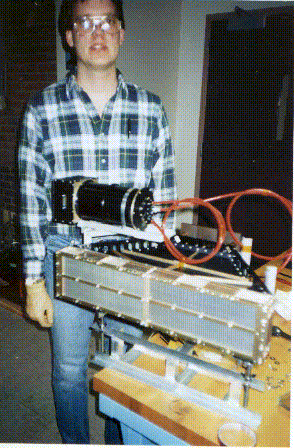Eric J. Lund
Research Scientist II, Space Science Center,
University of New Hampshire
S.B., 1989, Massachusetts Institute of Technology
Ph.D., 1996,
Dartmouth College
Research Interests:
Interaction between waves and particles
in space plasmas
One of the fundamental goals of space physics is the study of energy
transfer in plasmas. This energy can be present in the constituent
particles of the plasma, various waves that may exist in the plasma, and
in the configuration of the magnetic field in the plasma. There are many
ways, not all of which are understood, for the particles of the plasma
to acquire energy in such a way that the plasma is unstable to certain
waves, which obtain their energy from the unstable particle distribution.
These waves, in turn, dissipate and give their energy to the particles. This
back-and-forth energy transfer plays a key role in the dynamics of several
regions, including the bow shock and the auroral zone.
Current Projects
Cluster 2
We have built and are calibrating four instruments called CODIF (COmposition
and DIstribution Function). Each instrument, which is part of the
CIS (Cluster Ion Spectrometry) package, will fly on one of the four satellites
which will comprise the Cluster 2 mission. Launch is scheduled for
summer 2000.
Fast Auroral SnapshoT explorer (FAST)
Our group works with the TEAMS (Time-of-flight Energy Angle Mass Spectrometer)
instrument on FAST.
This instrument measures 3-D distributions of protons, alpha particles,
helium ions, and oxygen ions as well as mass spectra of minor ions in the
plasma.
My research is focusing on ion conics: ions which are accelerated
transversely to the geomagnetic field and then convert some of their energy
to motion along the field as they move into regions where the magnetic
field is weaker. This work has been published in
Geophysical Research Letters
and elsewhere.
Recent Past Projects
Advanced Composition Explorer (ACE)
 Our group has built the Solar Energetic Particle Ionic Charge Analyzer
(SEPICA) instrument on ACE.
In the photo below, I am holding the high-resolution collimator and electrostatic
analyzer for SEPICA in the deflection and imaging test configuration.
The engineering model high voltage supply, which is designed to supply
a nominal 30 kV to the center deflection plate of the electrostatic analyzer,
is mounted above the fan. (Photograph by Rick Miller, February 1996).
Our group has built the Solar Energetic Particle Ionic Charge Analyzer
(SEPICA) instrument on ACE.
In the photo below, I am holding the high-resolution collimator and electrostatic
analyzer for SEPICA in the deflection and imaging test configuration.
The engineering model high voltage supply, which is designed to supply
a nominal 30 kV to the center deflection plate of the electrostatic analyzer,
is mounted above the fan. (Photograph by Rick Miller, February 1996).
Contact Information:
Phone: (603) 862-0758
Fax: (603) 862-0311
E-mail: Eric.Lund@unh.edu
Snailmail:
- Space Science Center
- Morse Hall
- University of New Hampshire
- Durham, NH 03824
Recent Publications:
Full publication list
- Lund, E. J., J. LaBelle, R. B. Torbert, K. Liou, W. Peria,
C. A. Kletzing, M. C. Kelley, S. Baker, F. Primdahl,
H. C. Stenbaek-Nielsen, A. Ranta, G. Haerendel, and H. U. Frey, Observation
of electromagnetic oxygen cyclotron waves in a flickering aurora,
Geophys. Res. Lett.
22, 2465, 1995.
[Abstract |
Key Figure |
Request Reprint]
- Lund, E. J., and J. LaBelle, On the generation and propagation of
auroral electromagnetic ion cyclotron waves, J. Geophys. Res.
102, 17241, 1997.
[Abstract |
Download Zip File]
- Lund, E. J., M. L. Trimpi, E. H. Gewirtz, R. H. Cook, and J.
LaBelle, The plasma frequency tracker: An instrument for probing the
frequency structure of narrow-band MF/HF electric fields, in
Measurement Techniques in Space Plasmas: Fields, p. 169, American Geophysical
Union, Washington, 1998.
[Abstract |
Request Reprint]
- Lund, E. J., E. Möbius, L. Tang, L. M. Kistler, M. A. Popecki,
D. M. Klumpar, W. K. Peterson, E. G. Shelley, B. Klecker, D. Hovestadt,
M. Temerin, R. E. Ergun, J. P. McFadden, C. W. Carlson, F. S. Mozer,
R. C. Elphic, R. J. Strangeway, C. A. Cattell, and R. F. Pfaff, FAST
observations of preferentially accelerated He+ in association
with electromagnetic ion cyclotron waves, Geophys. Res. Lett.
25, 2049, 1998.
[Read It Online |
Abstract |
Key Figure |
Request Reprint]
- Lund, E. J., E. Möbius, D. M. Klumpar, L. M. Kistler, M. A. Popecki, B. Klecker,
R. E. Ergun, J. P. McFadden, C. W. Carlson, and R. J. Strangeway, Direct comparison of
transverse ion acceleration mechanisms in the auroral region
at solar minimum, J. Geophys. Res.
104, 22801, 1999.
[Abstract |
Key Figure |
Request Reprint]
Related sites to visit:
 Our group has built the Solar Energetic Particle Ionic Charge Analyzer
(SEPICA) instrument on ACE.
In the photo below, I am holding the high-resolution collimator and electrostatic
analyzer for SEPICA in the deflection and imaging test configuration.
The engineering model high voltage supply, which is designed to supply
a nominal 30 kV to the center deflection plate of the electrostatic analyzer,
is mounted above the fan. (Photograph by Rick Miller, February 1996).
Our group has built the Solar Energetic Particle Ionic Charge Analyzer
(SEPICA) instrument on ACE.
In the photo below, I am holding the high-resolution collimator and electrostatic
analyzer for SEPICA in the deflection and imaging test configuration.
The engineering model high voltage supply, which is designed to supply
a nominal 30 kV to the center deflection plate of the electrostatic analyzer,
is mounted above the fan. (Photograph by Rick Miller, February 1996).